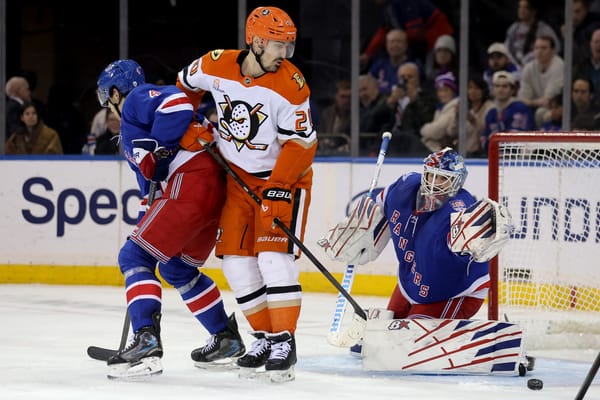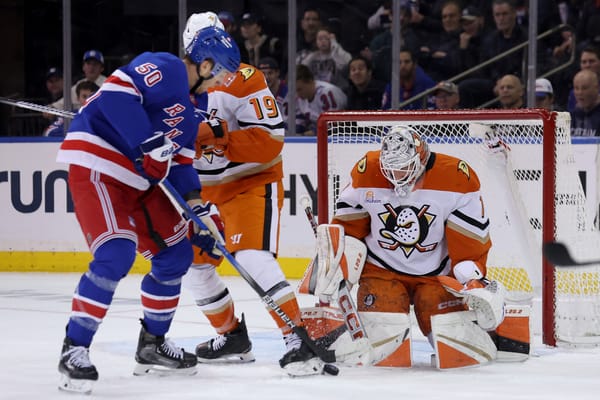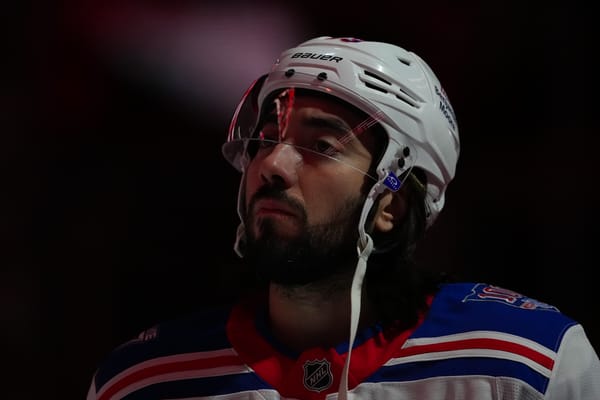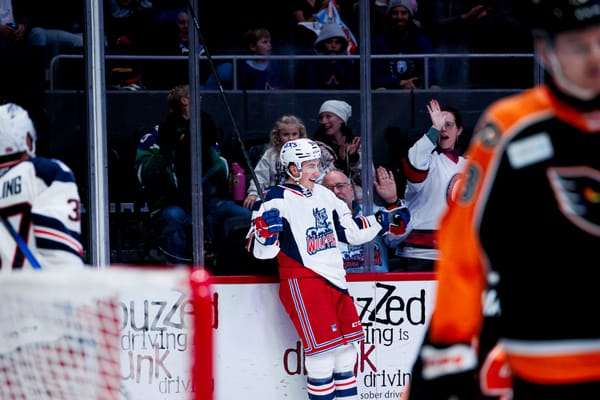Do the Rangers have a faceoff problem?
The Rangers are bad at winning faceoffs - but what does that really mean?
Chances are you have heard and/or read that faceoff percentage is an overvalued statistic. Casual observers need only watch a single game or a single period to note that not all faceoffs carry the same importance. Their value is highly influenced by circumstances that are beyond the control of the player who lines up at the dot. Furthermore, there is something to be said about measuring a player’s value in faceoffs based on what occurs after they are taken rather than leaning primarily on their winning percentage.
Off the Mark, On the Dot
Jeremy Davis of Canucks Army did a fine job of boiling down the central issue with faceoffs and their perceived value back in December.
The fact of the matter is that face-offs are just a small subset of the dozens and dozens of battles that take place during a hockey game. It’s important to get possession, certainly, but tracking possession won by face-off while ignoring possession changes resulting from corner battles, takeaways, dump and changes and so on can be highly misleading. Suggesting that face-offs are significantly more important than other battles simply because they represent that start of play would be disingenuous.
It should come as no surprise that losing defensive zone faceoffs is dangerous or that winning offensive zone faceoffs does leads to more shot attempts than losing them. It is also unsurprising that neutral zone faceoffs are more or less irrelevant when it comes to their impact and/or potential impact on offense.
From Daniel Weinberger of HockeyGraphs:
In fact, if you compare possessions that start with a NZ faceoff win to all other possible possession types, they consistently lead to the fewest shots and expected goals per possession.
Then there is the matter of how “clean wins” impact possession — not all faceoff wins are created equally. A puck scooped up by a winger after a stalemate between two centers on the dot is very different from a draw won straight back to a blueliner who almost instantly has a clear shooting lane and/or passing lanes.
Nick Czuzoj-Shulman and his collaborators presented a new approach to evaluating faceoffs at the MIT Sloan Sports Analytics Conference on Mar. 2019. Their research was built around the concept that some players consistently create post-faceoff-value by winning draws cleanly and to specific areas of the ice.
In fact, players who generate the most value from faceoffs do not necessarily have higher face-off win rates, suggesting that both win percentages and win value must be taken into account to measure the full impact generated during a draw.
It’s also important to remember that faceoffs are almost always impacted by random events and chaos. Why? Because we are dealing with a human dropping a squat cylinder of frozen rubber on an imperfect ice surface between two players who are likely trying to cheat as much as they can without getting tossed from the dot.
Fun, right?
The Rangers
Now that we have established that team faceoff percentage data is overrated, let’s look at how the Rangers have done on the dot over the last two decades.
Before the 2019-20 season was postponed, the Rangers had the second-worst team faceoff percentage in the league (46.6), ahead of only the Buffalo Sabres (45.9). Interestingly enough, the Rangers haven’t broke even in team faceoff percentage since the 2012-13 season and haven’t eclipsed 50% since the 2008-09 season.
So team faceoff percentage has been an area of concern and potential weakness for the Rangers since the team’s top three centers were Scott Gomez, Chris Drury, and Brandon Dubinsky. That’s a long time.
None of the Rangers who took at least 500 faceoffs in the 2019-20 season broke even in winning percentage. Mika Zibanejad led the pack (49.2%), followed by Brett Howden (48.2%) and Ryan Strome (47.5%) with Filip Chytil significantly behind with a 38.5 percent success rate — more on that in a moment.
It should be noted that, with the exception of Chytil, all of the aforementioned centers were far more successful on the power play and/or when the Rangers were in the offensive. For example, when the Rangers were on the man advantage, Strome won 57.4 percent of his draws.
Big Picture
So, why does this matter if faceoffs are, generally speaking, overvalued and if their actual value is poorly represented by a player’s faceoff percentage?
Over the past few seasons the Rangers have been filling their ranks with young, homegrown talent and we should expect the team to follow that course for the foreseeable future. Remember, that kid from Stranger Things called this a build and that means it ain’t done.
The future of the blue line looks promising – perhaps even overcrowded – but the Rangers forward prospects are an altogether different story. As important as it is for the team to develop talented wingers like Vitali Kravtsov, it’s even more important to groom young centers. And that means finding those kids ice time and opportunity.
Back in June I wrote why it was essential for the Rangers to return Chytil to the center position in training camp.
It goes without saying that there is a lot more to playing the center position than winning faceoffs, but it is a significant part of the position. Of the 23 rookies who took at least 175 draws in all situations last season, Chytil ranked 20th in faceoff percentage; Andersson ranked 11th (44.2 FO%) and Howden ranked sixth (48.6 FO%). Chytil’s struggles on the dot could have also influenced Quinn to move him to the wing, but the youngster deserves another crack at it.
Unfortunately, Chytil hasn’t improved much from his rookie season in terms of surface-level faceoff data. That’s relevant because Quinn has made it clear that winning draws is one of the reasons why the Czech youngster didn’t make the team out of training camp.
“You know, understanding how competitive you’re going to need to be on pucks, consistently. Faceoffs. Responsibilities defensively… His feel for the game in general,” Quinn told Newsday’s Colin Stephenson in October. “That comes with playing a lot and growing as a player. And right now, we feel that [Hartford’s] the best spot for him to do that in.”
This brings us to the real problem that the Rangers could be facing in the faceoff dot.
Counting on the Kids
Young centers struggling to adapt to faceoffs at the NHL level is nothing new. Quinn and the Rangers’ coaching staff need to find a way to strike a balance between performance and development and that is exceedingly significant when it comes to the team’s future centers like Chytil, Howden, Morgan Barron, and Karl Henriksson.
There are exceptions, but it is hard to overstate just how essential it is to develop your own talent down the middle. One needs only look at the Capitals or the Lightning to appreciate what kind of impact successfully developing young centers can have.
At times, it seems like a coach who was celebrated for developing talent at Boston University has leaned heavily on the belief that winning and the lofty expectations that come with it are the best teachers that young players can have. Of course, that can look counter-intuitive when prospects who are so integral to the future success and identity of the team are asked to adjust and develop while receiving fewer opportunities than players like Strome, Jesper Fast, and Phil Di Giuseppe.
At the end of the day, finding that balance between performance and development is what Quinn’s Rangers have been all about. Moving forward, it will be essential for the coaching staff to hone in on what they need to do to build the confidence and skills of the team’s youth at the center position. That, of course, includes what they do when they lineup for faceoffs.
Data courtesy of naturalstattrick.com, NHL.com.




